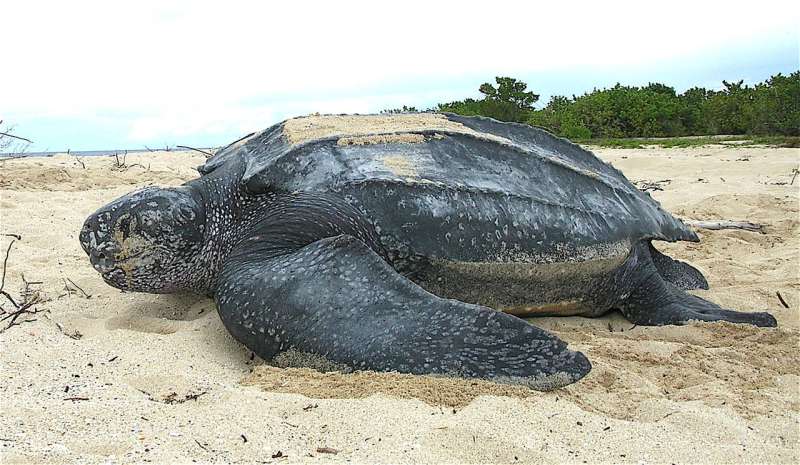Leatherback sea turtle. Credit: Public Domain
Some wonders of nature continue happening despite the global pandemic, and sea turtle nesting season is no exception. In Florida, those turtles are off to a strong start.
Along 13 miles of Brevard County's Archie Carr National Wildlife Refuge, UCF's Marine Turtle Research Group has logged 1,752 loggerhead nests, 29 leatherback nests and three green turtle nests. That represents a leatherback count higher than a full typical year—and the season continues until July—and the second earliest date a green turtle nest has been spotted by the UCF researchers.
While it's tempting to attribute nesting success to businesses closing and people staying home during the last two months, that's only a tiny part of a much larger story.
"Sea turtles are doing well so far this season in our area. But they didn't show up in Brevard County just because there were fewer people on the beach," said Erin Seney, an assistant research scientist with UCF's Marine Turtle Research Group. "They were already on their way—they may have come from the Bahamas, from Southwest Florida, from other regions."
A more likely reason behind this quick start to nesting season is mild winter temperatures in March and April that helped sea turtles along in their migration to Florida's beaches.
Along Indian River County's beaches, Coastal Connections, an organization that helps people connect with coastal wildlife, counted 531 loggerhead nests and 37 leatherback nests (a number tied with the 2019 year-end total) as of May 15, and they expect to see green turtle nests popping up soon.
"We're definitely seeing nests earlier than in previous years," said Kendra Cope, founder of Coastal Connections. "The odds for a really good year are in foreseeable sight. ... The last five years, we've broken record after record."
In addition to warmer temperatures aiding the start of this year's nesting season, Cope said that the surge in sea turtle nest numbers is a trend that's been ongoing during the last several years.
"It has been a generation since the turtles were listed on the Endangered Species Act in the early 1970s," she said. "We have regulations and protocols protecting turtles with fishing regulations, poaching is not allowed anymore and we have predator control."
And while the numbers of nests continue to rise, sea turtles still face threats from human activity, especially beach litter. During a recent Coastal Connections cleanup, volunteers picked up 91 pounds of trash from a stretch of Indian River County beach.
"It's unfortunate that this is normal to pick up 100 pounds of trash every time we do a public cleanup," Cope said. "Leave the beach better than how you found it, or just keep it natural. Knock down your sandcastles and fill in your holes."
Coastal Connections will host another cleanup on June 13 for those interested in pitching in. But Cope said people can make better choices for sea turtles every day by avoiding single-use plastics and exercising caution when walking on the beach at night to avoid nesting turtles.
In Brevard County, UCF's research group has noticed members of the public flagging nests with stakes or sticks. However, they're encouraging people not to do this, as it results in more unnecessary litter on the beach.
"Rest assured, we are counting," Seney said, noting that not every counted nest gets flagged.
This summer, Coastal Connections hopes to resume the popular turtle digs, an event helping to educate the public about sea turtles, assuming it's safe for people to gather again. In the meantime, Cope said it's nice to appreciate this year's early nesting success for what it is.
"It's just something really positive to think about in a world of pandemics and scares and negativity. There are a lot of beautiful things around us still happening," she said. "This is such a rare resource we get to enjoy."
More information: To learn more, visit sciences.ucf.edu and coastal-connections.org.
©2020 The Orlando Sentinel (Orlando, Fla.)
Distributed by Tribune Content Agency, LLC.






















